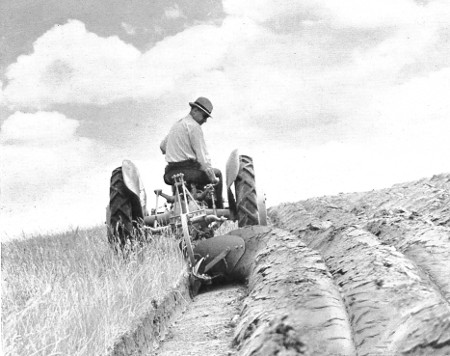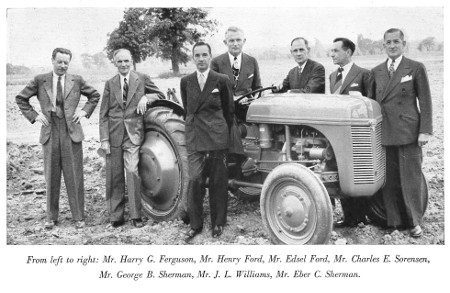By Robert Tate, Automotive Historian and Researcher
Images courtesy of the National Automotive History Collection
Posted: 03.27.2017

Many years ago, the doors had opened for the industrial age where man and machine had become a powerful force for agriculture in America. The man who saw the potential for marrying machine with farm work was Henry Ford, who spent his child hood on his father’s farm in Springwells Township (Southwest Detroit).
Mr. Ford was the pioneer for mass production of automobiles. Less well known is that Ford Motor Company also claims that Ford was the first to mass produce tractors for the U.S. farm industry.
The first experimental Ford tractor was built in 1907, and at the time, Henry Ford called it his “Automobile plow.” The first tractor came with an engine and copper water jackets and its rear wheels were taken from a binder. Ford called his first, mass-produced tractor the Fordson.
The tractor was first built for export in 1916 and 1917 and introduced to American farmers in 1918. On a historical note, The Fordson tractor had revolutionized all creative ideas of tractor design and efficiency. The mass-produced Fordson tractor created an affordable piece of valuable machinery to farmers, and made it possible for the average farmer to purchase a new and reliable tractor that many farmers thoroughly had enjoyed.
The Fordson tractor was the first lightweight, mass produced tractor on the market. The models sold for considerably less than competitive models. The name of the tractor, Fordson, was a contraction of the original name of the tractor operation, Henry Ford & Son.
In 1917, the British government had requested assistance from Mr. Ford to build large quantities of tractors to help raise urgently needed food to counteract the effect of an enemy blockade during World War I.
During the 1920s, 75 percent of all tractors built in the United States were Fordsons. The tractors could also be used for hauling lumber, coal, brick and other material and sometimes even switching loaded freight cars, the removal of snow from sidewalks and many other industrial uses as well. In all the various uses, the Fordson tractor was proving to be a very profitable investment for the growing Ford Motor Co.
The Fordson did the work faster and more economically than other tractors. When it was called upon to replace horses, the Fordson tractor had demonstrated its market dominance. Henry Ford and Harry Ferguson.In 1928, Fordson tractor production was halted in the United States, only to be resurrected in 1939 as the Ford Model 9N. About that time, Henry Ford began to develop a working relationship with the late Harry Ferguson. The Ferguson-Sherman company, which made plow and tractor parts, marketed the Model 9N for sales distribution from 1939-1946. After the war, all production of the Ford Model 9N tractor was halted. In 1946, the relationship between Harry Ferguson and Ford Motor Company severed.
Henry Ford and Harry Ferguson.In 1928, Fordson tractor production was halted in the United States, only to be resurrected in 1939 as the Ford Model 9N. About that time, Henry Ford began to develop a working relationship with the late Harry Ferguson. The Ferguson-Sherman company, which made plow and tractor parts, marketed the Model 9N for sales distribution from 1939-1946. After the war, all production of the Ford Model 9N tractor was halted. In 1946, the relationship between Harry Ferguson and Ford Motor Company severed.
The year 1953 marked the 50-year anniversary which was dubbed the “Golden Jubilee” celebration. In January of that year, Ford introduced the model NAA tractor and was marketed as the Golden Jubilee model in recognition of the company’s 50th anniversary.
On May 30, 1953, Ford Motor Company announced that commencing August 1 of that year that they would assume distribution of the Ford Tractor and many lines of farm equipment for a growing and competitive market. A listing of all Henry Ford's Village Industries.In 1955, Ford Motor Company introduced a new line of tractors with five new models offered to the public in two power classes – 600 and 800 series. The models were called Ford's row-crop tractors and they were built to handle front-mounted equipment. In early 1957, all Ford tractors models became available with factory installed LP gas engines in addition to the gasoline models.
A listing of all Henry Ford's Village Industries.In 1955, Ford Motor Company introduced a new line of tractors with five new models offered to the public in two power classes – 600 and 800 series. The models were called Ford's row-crop tractors and they were built to handle front-mounted equipment. In early 1957, all Ford tractors models became available with factory installed LP gas engines in addition to the gasoline models.
In March of 1961, Ford had introduced the Ford 6000 tractor, which was the largest and most powerful tractor ever put in production by Ford. A six-cylinder high performance diesel engine powered the model.
In conclusion, Ford Motor Company has always had along and great history manufacturing tractors for the farm industry that will always be a part of Ford's great legacy and heritage.
Henry Ford once said, “I have walked many a weary mile behind a plow and I know all the drudgery of it.”
A special thanks to Robert Tate, Automotive Historian and Researcher, for contributing this story to the MotorCities Story of the Week Program. 
For further information on photos please visit http://www.detroitpubliclibrary.org/ or email This email address is being protected from spambots. You need JavaScript enabled to view it.. Please do not republish the story and/or photographs without permission of MotorCities National Heritage Area. (Bibliography: Ford Motor Company, “The new Fordson agricultural tractor” August 5 1953; Ford Motor Company, “Invitation to the land” Press material June 29, 1939, Dearborn Michigan; Dammann, H. George, “Illustrated History of Ford,” Crestline Publishing Company 1970; The Detroit News Friday, April 7, 1967. “Ford Fetes 50th Tractor Year.”)
If you would like to contribute an article for the MotorCities newsletter, email This email address is being protected from spambots. You need JavaScript enabled to view it. or call 313-259-3425.



